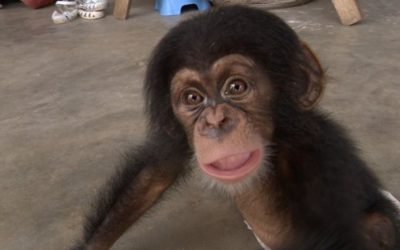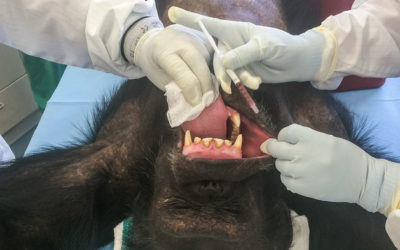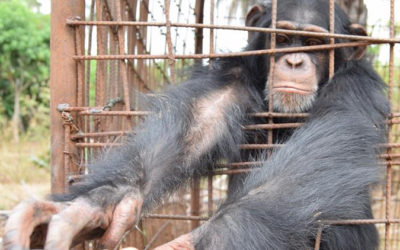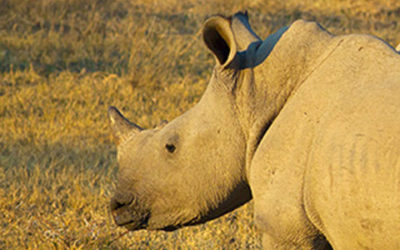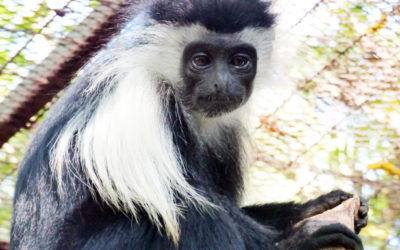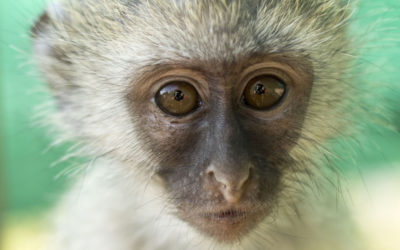How Can You Reduce Climate Change by Helping Protect Great Apes?
New Data Show that Climate Change Is Causing Massive Tree Die-Offs in Africa
By Natasha Tworoski
It’s hard to find a place on the planet where scientific evidence isn’t showing global climate change taking a drastic toll on wildlife and ecosystems. Tragically, this includes the lush forests of Africa and its diverse wildlife.
Africa’s Congo Basin is the second largest rainforest in the world, reaching across six countries, and is home to the greatest number of primates, mammals, birds, fish and swallowtail butterflies of any region of Africa. It also hosts Africa’s second longest river, the Congo River, an important source of water for wildlife and people. Like so many wild places, the Congo Basin is an indicator of the dramatic changes our planet is now undergoing.
NASA satellite imaging and the highly sensitive Enhanced Vegetation Index can reveal the amount of greenness, an indicator of forest health. While the loss of vegetation, referred to as “browning,” has been occurring in the Amazon at a rapid rate, imaging recorded in 2014 showed browning in the Congo Basin is now a major concern there as well. Increasing land surface temperatures and decreased cloudiness are causing large scale tree mortality, which in turn exposes more of the Earth’s surface to the effects of rising temperatures, increasing the rate of climate change.
With deforestation already a huge threat to wildlife in the Congo Basin, this evidence that the remaining forest is deteriorating due to climate change is disheartening news.
A new horrifying threat has just been published this week in the highly respected peer-reviewed journal Nature. Satellite imaging of the Congo Basin’s Cuvette Centrale peat lands, which exist across the Republic of Congo and the Democratic Republic of Congo, have been found to hold 30 billion tons of carbon. This amount is equivalent to 3 years of global emissions. While peat lands only cover 3% of the planet’s surface, they are responsible for one third of soil carbon. The frightening problem comes when peat lands are dug up, usually to create new farm land, and the carbon is released from the earth and into the atmosphere. While the Cuvette Centrale peat lands are not yet being destroyed, the rapidly growing trend of palm oil plantations in Africa mean this could be a very real risk in the near future.
Fortunately, the Cuvette Centrale peat lands are located in a region that is highly inaccessible, which is likely the reason they have not been disturbed to date. The peat lands also have a champion in their corner – this area is home to one of the highest densities of gorillas in Africa.
By protecting one of our closest relatives and their habitat, we are also protecting all of us from the devastating effects of climate change.
Please donate today to help protect African primates and their habitat – before it’s too late.
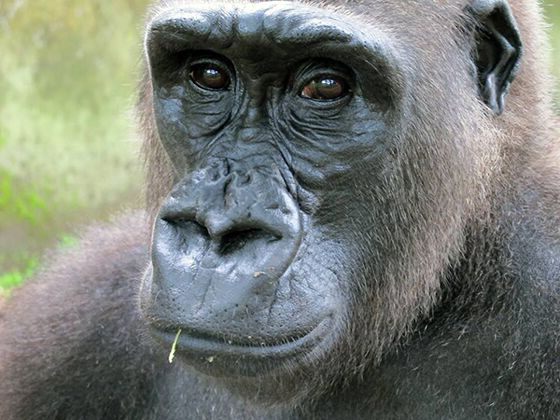
Protecting an area with the largest concentration of gorillas in Africa also prevents disruption of peat lands, a major risk for release of carbon into the atmosphere.
Next Posts
What Can You Accomplish by Donating to PASA?
Although PASA started as a way to connect primate rehabilitation centers, it has grown substantially over the years and now strengthens its members in more ways than ever.
Nemley Junior: A Tiny Chimpanzee with a Not-So-Tiny Impact on Illegal Wildlife Trade
Nemley Junior: A Tiny Chimpanzee with a Not-So-Tiny Impact on the Illegal Wildlife Trade A heartbreaking tragic death of an orphaned baby chimp and the unsettling aftermath by Jennifer Harris Nemley Junior, a tiny orphaned baby chimpanzee, was about to be stuffed into...
Are Conventional Conservation Approaches Holding us Back? The Ethics of Give and Take
Are Conventional Conservation Approaches Holding us Back? The Ethics of Give and Take Working with corporations to forge new paths to conservation by Natasha Tworoski When it comes to complex issues such as protecting our remaining wildlife and wild places, solutions...
Japan’s Only Ape Sanctuary Arose from a Pharmaceutical Research Facility
Japan's Only Ape Sanctuary Arose from a Pharmaceutical Research Facility Japan's apes are helping us to better understand our closest relatives by Natasha Tworoski High in the hills of the Kumamoto Prefecture in southwestern Japan are some unexpected residents. This...
A Wild Idea, Literally: Research on Vaccinating Endangered Wild Apes against Deadly Ebola
A Wild Idea, Literally: Research on Vaccinating Endangered Wild Apes against Deadly Ebola Viral mutation and spread to wild apes are the risks. By Jen Harris Since the 1990s, an estimated one-third of the world’s gorilla population and a similar fraction of...
Four Rescued Chimpanzees in Desperate Need of Help!
Four Rescued Chimpanzees in Desperate Need of Help! Smugglers' leader and several others arrested. By Natasha Tworoski Four young chimpanzees were just rescued from deplorable conditions at a roadside facility in Guinea. A collaboration between WARA Conservation...
New Study Shows the Impact of PASA Members on Primate Protection
New Study Shows the Impact of PASA Members on Primate Protection PASA wildlife centers are making a difference through education, community development, animal rescue and long-term care. By Natasha Tworoski Across the continent of Africa, wildlife sanctuaries are...
Brutal Attack on Rhino Sanctuary
Brutal Attack on Rhino Sanctuary Staff were beaten and rhinos killed for their horns By Natasha Tworoski An incredible act of violence occurred late at night on Monday, February 20th at the Thula Thula Orphanage in South Africa. Several staff and two rhinos were...
Returning to the Wild: Possible but Costly
Returning to the Wild: Possible but Costly First Colobus troop going back to the wild! By Natasha Tworoski The coast of Kenya is home to a spectacular range of wildlife. Here you will also find dedicated PASA member, Colobus Conservation. The face of this organization...
Five Rescued Monkeys Make the World a Better Place
Five Rescued Monkeys Make the World a Better Place Finding safe haven for themselves and other species. By Natasha Tworoski If video footage of extremely adorable baby monkeys is your thing, boy are you in luck! A new film, “The Vervet Forest,” is now being screened...


